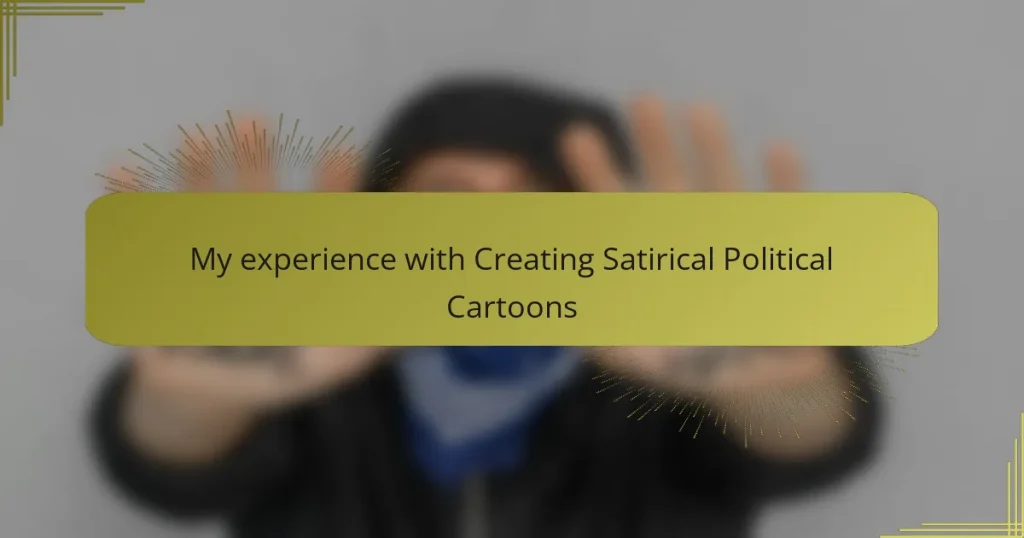Key takeaways
- Political satire awards celebrate creativity and impact, encouraging discourse on political issues through humor across various mediums.
- Political cartoons serve as a powerful tool for accountability, raising awareness of societal issues and provoking meaningful discussions.
- Effective satirical cartoons balance humor with clarity, exaggeration, and relatability to engage audiences and convey complex messages.
- Creating political cartoons involves navigating challenges such as relevance, audience interpretation, and the fine line between humor and offense.
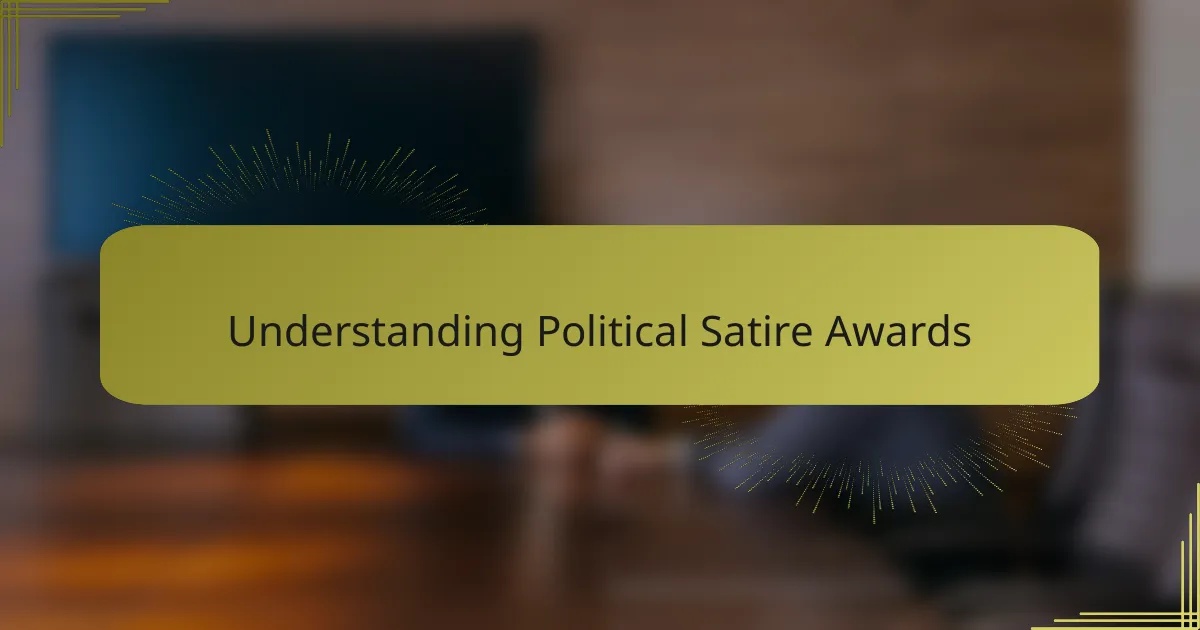
Understanding Political Satire Awards
Political satire awards serve as platforms that recognize and celebrate the creativity and impact of artists who employ humor to comment on political issues. From my experience, these awards not only highlight the talent of cartoonists but also underscore the importance of satire in fostering political discourse. I remember the thrill of seeing one of my cartoons nominated; it felt like validation that humor could spark conversations about real-world issues.
One of the most intriguing aspects of political satire awards is their recognition of diverse mediums—from editorial cartoons to animated shorts. I often find myself reflecting on how different styles can convey powerful messages in unique ways. Each award might prioritize various elements such as creativity, relevance, and audience impact, making the competition both exciting and varied.
Here’s a brief comparison of some notable political satire awards:
| Award Name | Focus Area |
|---|---|
| The Herblock Prize | Editorial Cartoonists |
| The George Polk Awards | Investigative Journalism |
| The Mark Twain Prize | Influential Comedians |
| The National Cartoonists Society Awards | Various Cartooning Styles |
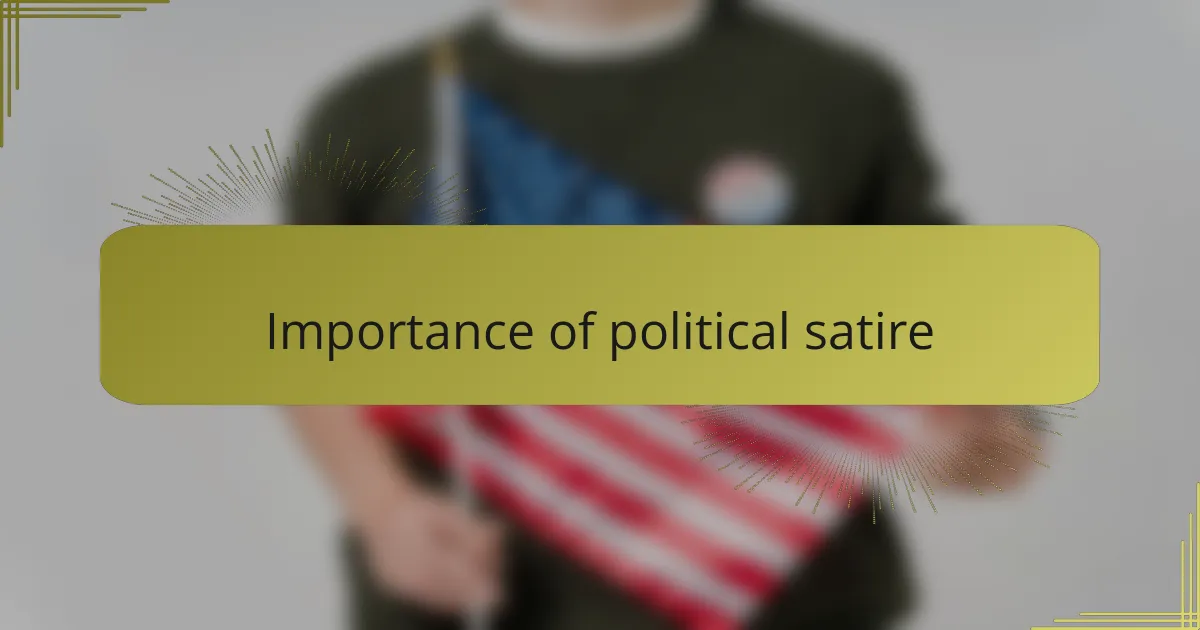
Importance of Political Satire
Political satire plays a crucial role in shaping public opinion by using humor to dissect complex political themes. I’ve often found that a well-crafted cartoon can provoke thought in a way that traditional news articles sometimes can’t. When I observe people laughing at my work, I see not just amusement, but a spark of understanding that might lead to deeper conversations about pressing issues.
In my experience, satire can serve as a powerful tool for accountability. By highlighting absurdities in political behavior, we shine a light on actions that might otherwise go unnoticed. I remember a time when a particularly biting cartoon I created sparked discussions in my community about corruption. It reminded me how effective humor can be in rallying people to pay attention to what’s happening around them.
Moreover, political satire fosters a sense of resilience in society. During challenging political climates, humor becomes a refuge for many. I’ve seen individuals come together to discuss my cartoons over coffee, sharing laughs and reinforcing their connections. Doesn’t that illustrate how laughter not only entertains but also builds community in the face of adversity?
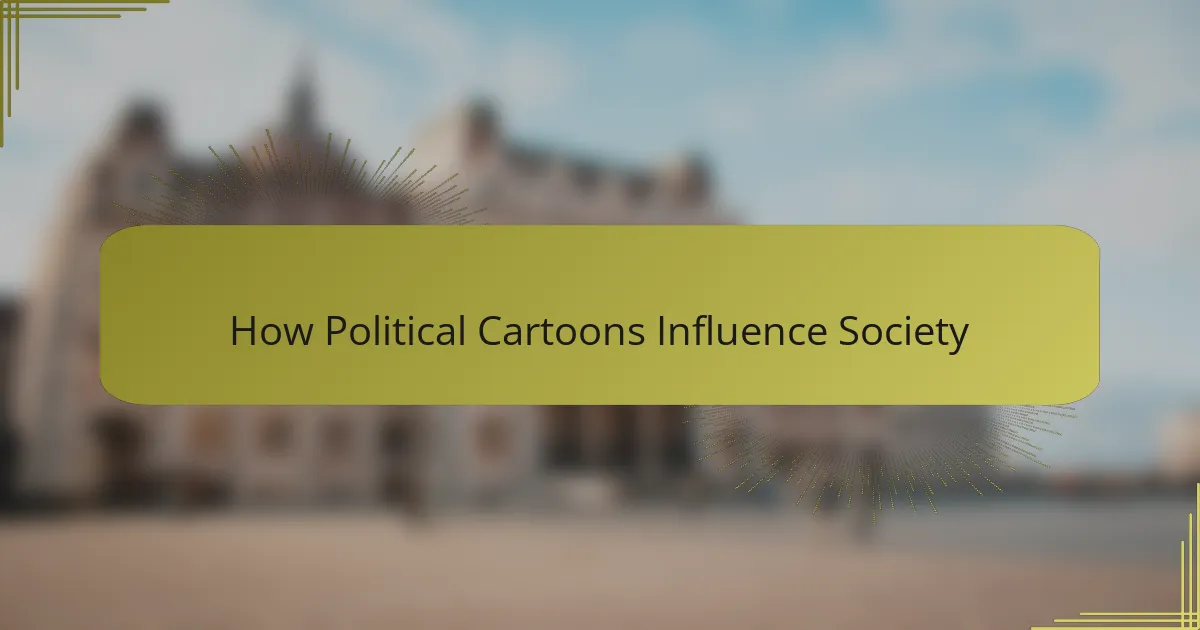
How Political Cartoons Influence Society
Creating political cartoons has shown me how powerful art can be in shaping public opinion and fostering discussion. These cartoons can highlight societal issues and spark conversations that might not happen otherwise. For me, it’s been fascinating to witness how a simple image can evoke laughter, anger, or reflection, urging people to think critically about the political landscape.
When I first started drawing satirical cartoons, I noticed how they resonated with different audiences. For instance, after illustrating a particular political controversy, I received varied responses—some found it hilarious while others felt it was too harsh. It reminded me of the incredible weight a single cartoon can carry, influencing perspectives and, at times, even mobilizing individuals toward action.
The connection between humor and serious issues is profound. I believe that when people are entertained, they are more likely to engage with the underlying messages. This emotional layer is what makes political cartoons a unique medium, blending art and advocacy seamlessly.
| Impact | Examples |
|---|---|
| Raises Awareness | Highlights social injustices through humor. |
| Encourages Dialogue | Provokes discussions on controversial topics. |
| Influences Public Opinion | Shapes how society views political matters. |
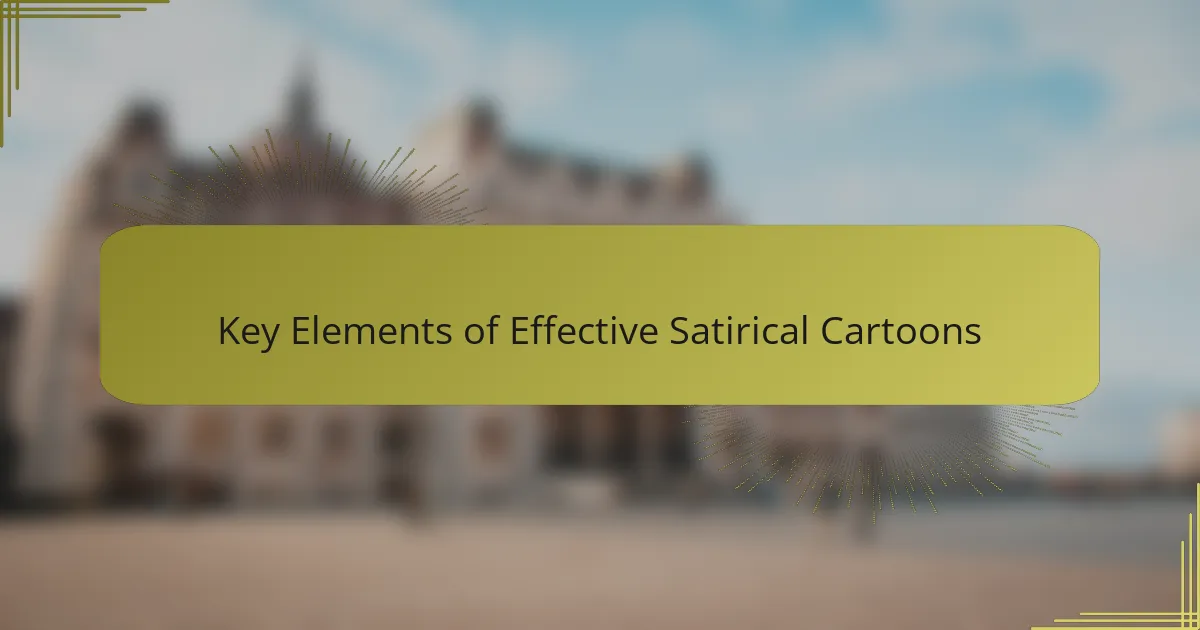
Key Elements of Effective Satirical Cartoons
When creating effective satirical cartoons, it’s essential to strike a balance between humor and political commentary. From my experience, clarity in the message is crucial; a well-crafted cartoon can convey complex ideas quickly, making the viewer think while they laugh. Incorporating exaggeration adds another layer, amplifying traits or situations to emphasize absurdities in politics.
The use of relatable characters and familiar scenarios can also foster a connection with the audience. For instance, I once drew a cartoon featuring a politician tripling down on a ridiculous promise. It resonated with readers because they recognized the folly in real-world events. Ultimately, timing and creativity play significant roles, as capturing the right moment can turn a simple idea into a memorable commentary.
| Element | Description |
|---|---|
| Humor | Using wit to make serious topics more approachable. |
| Clarity | Presenting the message clearly and concisely to ensure understanding. |
| Exaggeration | Amplifying traits to highlight absurdities in political situations. |
| Relatability | Incorporating characters/scenarios that the audience can connect with. |
| Timing | Capturing current events to enhance relevance and impact. |
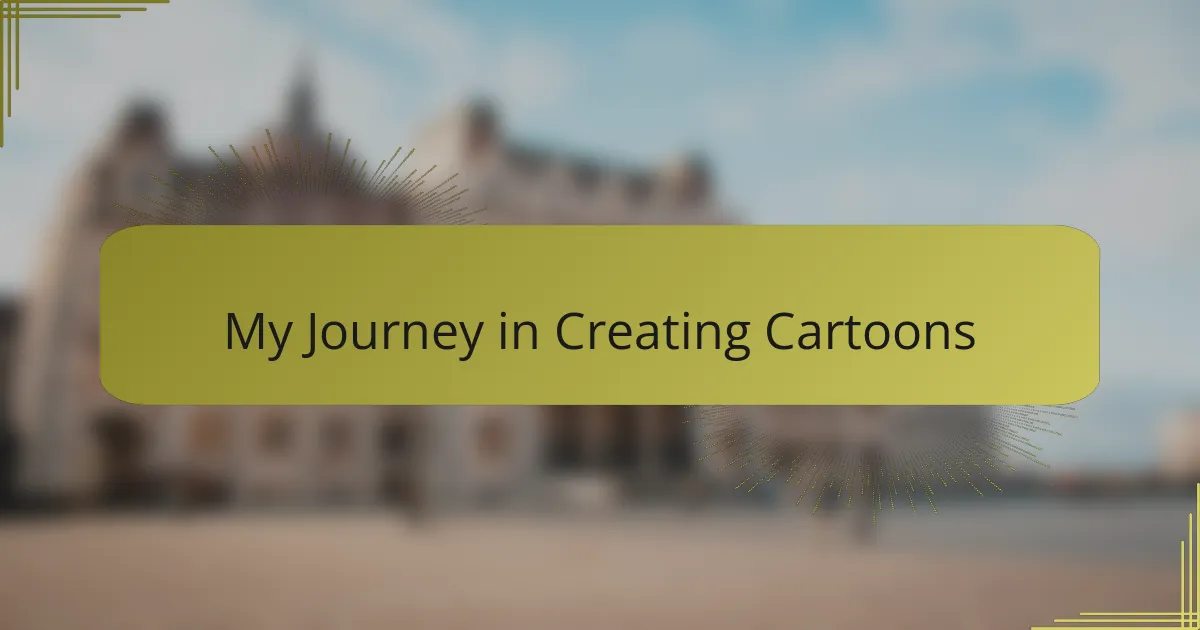
My Journey in Creating Cartoons
Creating cartoons has been a transformative journey for me, one that began with a simple pencil and paper. I vividly remember the exhilarating moment I sketched my first satirical piece, feeling a sense of purpose wash over me. It was as if I had discovered a unique voice that could challenge the status quo while also inviting laughter—what a powerful combination!
As I honed my skills over time, I encountered both triumphs and struggles. I remember a particular cartoon that felt like a breakthrough for me; it tackled a contentious political issue and sparked a flurry of discussions among my friends and family. Have you ever felt the thrill of your work igniting conversations? It felt like a light bulb moment, reminding me how vital satire is in pushing people to reflect on their views.
I’ve found that creating cartoons requires not just artistic talent, but also a deep understanding of the world around us. The more I engaged with current events, the more layered my cartoons became. Every nuance in a political landscape provided fodder for humor, and the reactions from my audience became my gauge of success. That immediate feedback loop is both exhilarating and humbling, and it pushes me to keep refining my craft. Do you think satire can truly change perspectives? I believe it can, one cartoon at a time.
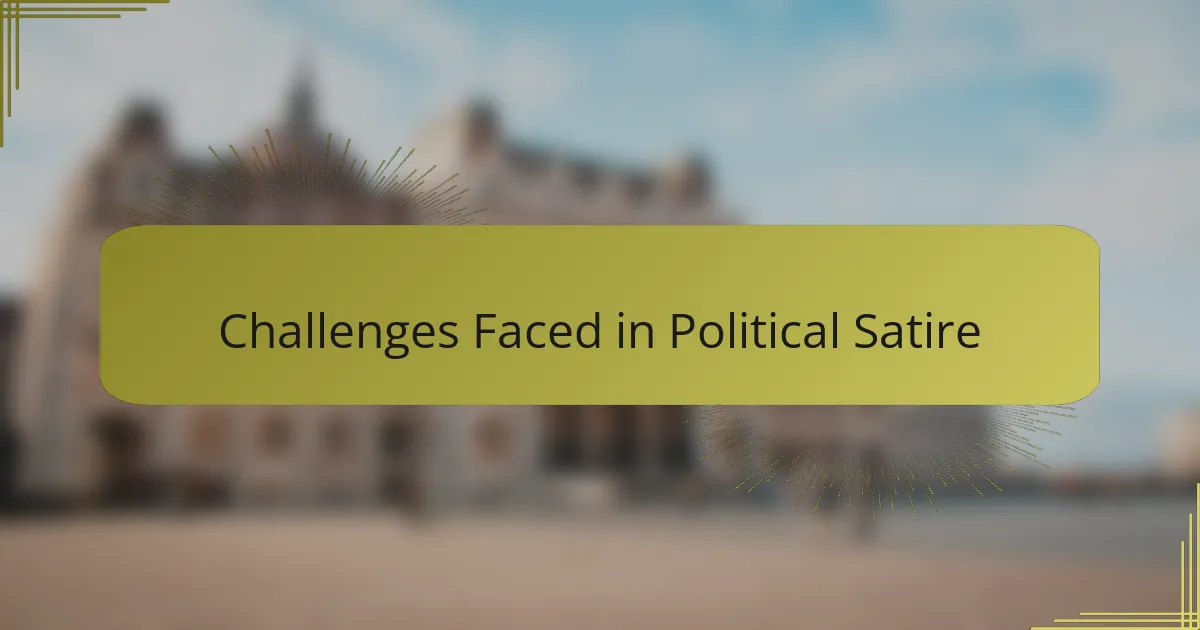
Challenges Faced in Political Satire
The world of political satire is not without its hurdles. I often find myself navigating the fine line between humor and offense. For instance, when I created a cartoon about a controversial policy, the feedback was mixed. Some loved the boldness, while others felt it crossed a line. This taught me that intent doesn’t always align with interpretation—how do I ensure my humor resonates positively with my audience?
One significant challenge I face is staying relevant in a rapidly changing political landscape. As news cycles churn through scandals and theories faster than I can draw, I sometimes struggle to capture the humor in the moment. I remember working late into the night, trying to craft a timely piece that reflected the chaos, only to feel the cartoon lost its edge by morning. It’s a daunting task; how do you effectively comment on something that’s already shifted by the time your work sees the light?
Moreover, there’s the ever-present risk of misunderstanding or backlash. I once illustrated a piece that poked fun at a political figure’s blunder, and the reactions were polarizing. While many found it funny, some interpreted my work as an unfair attack. This experience taught me that while satire is meant to provoke thought, the responsibility that comes with it is immense. How do I navigate that responsibility while remaining bold and authentic in my expressions?
